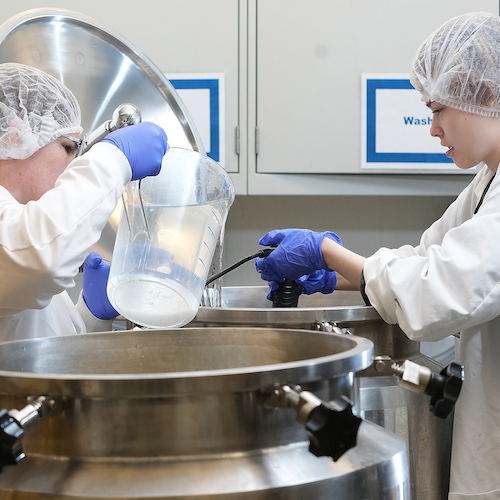C aitlin Proctor, assistant professor of agricultural and biological engineering, wants to know what well owners in rural Indiana think about their water quality. Instead of searching for funds outside of the university to conduct such a study, Proctor will use a grant unique to the Purdue College of Agriculture to survey well owners and to study the well water’s microbiome.
 Proctor is using an AgSEED grant to collect better data about threats to well water quality. This information could help Indiana well owners take control of their water safety and make informed decisions that affect their health.
Proctor is using an AgSEED grant to collect better data about threats to well water quality. This information could help Indiana well owners take control of their water safety and make informed decisions that affect their health. Diane Wang, assistant professor of agronomy, will use the same internal funding source to collect physiological data on soybeans in an innovative approach that may one day become the basis for a new tool for soybean breeders.
Proctor, Wang and other Purdue University researchers are making exciting discoveries through the competitive grant program called AgSEED — Agricultural Science and Extension for Economic Development. The Indiana Legislature funded AgSEED in 2013 to foster the state’s leadership in plant and animal agriculture and rural growth.
Faculty and staff in the colleges of Agriculture, Health and Human Sciences, and Veterinary Medicine may apply for grants to fund basic research or applied research and Extension. The awards of $50,000 for one-year projects or $75,000 for two-year projects are modest by external standards, but they have successfully helped researchers lay the groundwork for future projects and larger funding.
Since 2014, $7.5 million in AgSEED grants have enabled researchers to secure more than $21 million in additional funds.
The 15 projects funded in 2022 span a broad range of challenges in both basic and applied science, from exploring whether vocalizations in the poultry barn could indicate flock welfare; to using genomics to predict the reproductive quality of male honeybees; to producing a succession toolkit to help farmers plan for the future.
The AgSEED program encourages project leaders to assemble teams across academic specialties and disciplines. Proctor is leading a team of Purdue scientists, Extension educators and representatives from the state Department of Health.
Although microbial water quality in utilities and large buildings is researched extensively, little attention has been paid to rural water, she says. This project spotlights the need to better understand rural water infrastructure, especially under disaster conditions such as flooding.
The researchers will follow up on the survey with microbiological testing to get an overview of the microbial health of these water systems. “We hope that our preliminary data will illuminate the needs of Indiana residents so that we can help provide better support,” Proctor says.
If testing wells with known issues reveals fecal contamination, microbial source tracking will help identify the source. The study will also quantify other microbial threats, including opportunistic pathogens.
Results will inform new Extension education products and create preliminary data for future studies.
Wang’s project asks a fundamental question in a new way. She will collect physiological data — how soybeans respond to environmental factors such as water, solar radiation, wind speed or humidity — across genetically diverse germplasm. The study includes important breeder-nominated lines from Indiana and across the Midwest, and others collected globally but that are still able to flower and set seed in Indiana.
Wang is measuring the traits to design a new process-based model. These computer models, which date to the 1960s, simulate how plants grow throughout a changing season. “Historically, they’ve been utilized to ask the question, ‘What is the effect of a certain agronomic management scheme on the performance of my crop?” she says.
Rather than focusing on differences across crop species, however, Wang reimagines physiological process-based models organized around genetic variation to create a new tool for soybean breeders. By capturing intra-specific genetic diversity, the models may answer a new question: “How is my new line going to perform under variable conditions?”
The AgSEED grant will enable her team — a soybean breeder, soybean geneticist, and field agronomist who complement Wang’s skills as an ecophysiological modeler — to compile critical preliminary data.
“If we’re thinking about breeding, especially for novel climatic scenarios, we may need to reach beyond our current gene pool,” Wang says. “Understanding how to evaluate, combine and deploy new genetic variation is a cornerstone of varietal crop improvement.”
Proctor’s and Wang’s projects will join a growing list of AgSEED success stories. Grants to date have resulted in 93 publications and three patents; funded 168 graduate students and postdocs; and involved 320 undergraduates in AgSEED research.
Banner Image: Diverse accessions of soybean. Wang’s AgSEED project will gather data to provide a proof-of-concept for architecting new physiological process-based models using genetic variation as a key organizing concept.





